Is any synthetic jack allowed in FIPJP competition play?
This post is a short summary. See also our post on Rules governing the jack.
Q: Is any synthetic jack allowed in FIPJP-approved competitions? A: NO.
The requirements for a synthetic jack to be allowed in competition play
In order to be allowed in competition play, a synthetic jack must be both “approved” and “legal”.
- APPROVED The FIPJP document called Fabricants de Boules: Labels des Boules et Buts agréés en compétition contains a list of the models of synthetic jacks that are approved (agréés) by the FIPJP for use in competition play. In order to be approved for competition play, a synthetic jack must be on this list. As of April 2024, the only synthetic jacks on the list are the VMS resin jack and the Obut “black jack”.
- LEGAL Article 3 of the FIPJP international rules for the sport of petanque specifies size and weight requirements for jacks. To be legal, a jack must be between 29 and 31 mm in diameter and weigh between 10 and 18 grams.
Commercially available synthetic jacks
As of April 2024, four models of synthetic jacks are commercially available.
- The VMS resin jack is approved but not legal. This jack, available in multiple bright colors, was introduced in 1996 as a promotional gimmick for VMS’s new tortue (“tortoise”) boules. It weighs 20g, which means that it is too heavy to be legal.
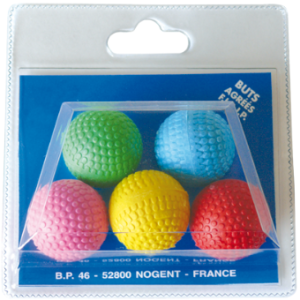
- Obut’s “black jack”, which was introduced in 2013, is approved but not legal. It is made of hard epoxy resin mixed with iron filings. It is paramagnetic, which means that it can be picked up with a magnet. It weighs 22g, which means that it is too heavy to be legal.
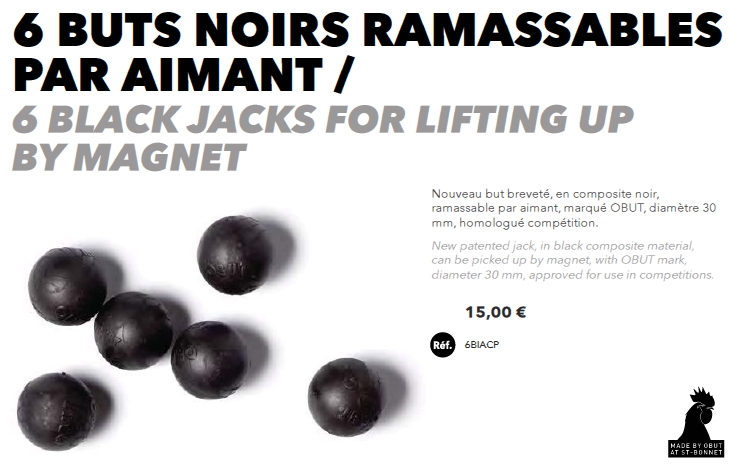
- The Geologic “red jack” (from Decathlon, a sporting goods retailer) is legal but not approved. It is made of acrylonitrile butadiene styrene with a solid iron core that makes it paramagnetic. It is 29.5mm in diameter and weighs 17g.
It meets the size and weight requirements in the rules, but Geologic hasn’t sought official approval for it. The Decathlon webpage states— Use restriction: This jack cannot be used in official competitions.
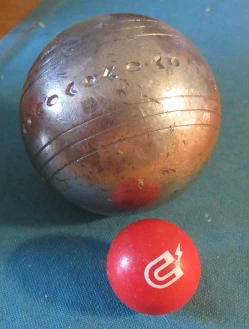
- Geologic also sells bright fluorescent yellow, non-paramagnetic, “recreational” jacks. These jacks are legal but not approved. They are 29mm in diameter and weigh 11g. They meet the size and weight requirements in the rules, but they are designed for recreational use (like leisure boules) and Geologic hasn’t sought official approval for them.
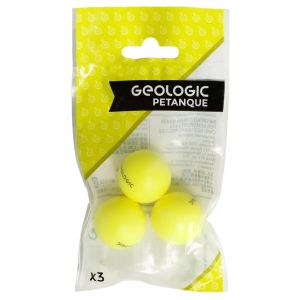
Note that your local rules may allow some of these jacks in social play. When the VMS and Obut epoxy resin jacks were introduced, safety concerns got them banned from official competitions. Similar concerns have not been raised about the Geologic jacks, which weigh less and are made of a different synthetic material.
If you want a paramagnetic jack for use in social games, we recommend Geologic’s red jack, or making your own magnetic jack.
Dealing with a forgotten boule
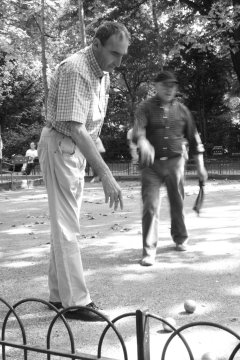 There are a lot of boules on the ground. Team A has the point and one unplayed boule. Team B should play next, if they have any unplayed boules.
There are a lot of boules on the ground. Team A has the point and one unplayed boule. Team B should play next, if they have any unplayed boules.
Team A asks Team B if they have any more boules to play. Team B says “No, we’re out.” So Team A plays its last boule. Then one of the players on Team B says “Ooops! I still have one boule left!”
Should Team B be allowed to play its forgotten boule?
In this post I present reasons for ruling that Team B should NOT be allowed to play its forgotten boule.
In this situation, the bottom line is that Team A gave Team B the opportunity to play next, and Team B refused to do so. We don’t know why Team B refused. Perhaps Team B genuinely made a mistake. Perhaps they deliberately tried to cheat. We can’t retroactively read their minds, so we can never be sure. But it makes no difference why they violated the rules (General Principle #1). Carelessness and sloppiness are just as unacceptable as deliberate cheating. The bottom line is that Team B broke the rules.
The judgement that Team B broke the rules rests on the premise that it is a violation of the rules to refuse to play when it is your team’s turn to play. Just as a boule can be played contrary to the rules, a boule can be withheld from play contrary to the rules.
An alternative interpretation of the rules would hold that Team B, in refusing to play when it was their turn to do so, in effect declared that they had played all of the boules that they intended to play, and in doing so they gave up the right to play any more boules.
Under either interpretation, the bottom line is— Team B may not play their last boule. A forgotten boule is dead and may not be played.
The Forgotten Boule and the Boule Advantage
Most importantly, there is a very pragmatic reason for why a team must not be allowed to play a “forgotten” boule. It is connected to the notion of the boule advantage. Let’s look at a scenario in which a team is allowed to play a “forgotten” boule. Team A has just taken the point, leaving both teams with one unplayed boule.
- Team A turns to Team B and says “We have the point. Do you have any unplayed boules?”
- Team B (conveniently failing to remember or notice its unplayed boule) says “We’re out of boules.”
- Team A says “OK” and throws its last boule. Team A now has game on the ground.
- Team B says “Oops. I just noticed! We still have one more boule!”
- The umpire agrees to let Team B throw its “forgotten” boule.
- Team B plays its final boule. With that boule it takes the point, wins the mene, and wins the game.
Team A had the boule advantage at the beginning of this scenario, but Team B ended up throwing the last boule. How did THAT happen? It happened because Team B conveniently “forgot” its unplayed boule. This forced Team A to throw its last boule. When the dust settled and Team B was allowed to play its “forgotten” boule, Team B had the boule advantage. And it used that advantage to win the mene and the game. This clearly violates unwritten petanque General Principle #2,
The No Unfair Advantage Rule — An offending team may not benefit from its illegal action. If the offending team performs an illegal action (deliberately or not) and thereby gains some advantage, that advantage is unfair because it was gained illegally. That advantage should be removed by whatever corrective action we decide to take.
This is why a team must NOT be allowed to throw a “forgotten” boule.
How NOT to think about a forgotten boule
It is sometimes argued that a forgotten-boule situation is really a boule-thrown-out-of-turn situation. Team A, the argument goes, simply made a mistake about who should throw next, and they threw their boule out of turn. Therefore, under current FIPJP rules, play should carry on normally and Team B should throw their last boule. This is rubbish. Team A wasn’t lazy and they didn’t simply make a mistake. Team A made a genuine effort to determine if Team B had any unplayed boules, and it was actively misled by Team B.
It is sometimes argued that Team A wouldn’t have thrown their last boule if they had first counted the boules on the ground, so Team A is somehow at fault for “playing a boule out-of-turn”. It’s true that keeping a mental count of the boules played is a useful practice, but this argument is rubbish. It ignores the fact that if anyone should have been counting their boules, it was Team B, not Team A. And it ignores the fact that asking your opponents if they have any unplayed boules (and accepting their answer as truthful) is a perfectly reasonable thing to do.
Still a controversial topic
I hope that I’ve presented a clear and reasonable argument for this interpretation of the rules. Remember, however, that as of October 2023 this is still a controversial topic, and there are players and umpires who still hold that Team B should be allowed to play their last boule. For example, on October 27, 2023, international umpire Mike Pegg ruled that the player with the poor memory has the right to play his/her boule. But personally I would have a word with the player’s teammates if they were to try the same stunt more than once.
The bottom line is that there is no written FIPJP ruling on this question. (Nothing comparable, for example, to the FIPJP’s memo about boules played out-of-turn.) Players and umpires, therefore, must consider the arguments pro and con for themselves, and make their own decisions about what seems to be most reasonable, most compatible with the written FIPJP rules, and most compatible with the unwritten general principles for applying the rules.
NOT a boule played out-of-turn
In closing, I think it is important to emphasize that a forgotten boule situation is NOT the same as a boule played out-of-turn situation. In a boule played out-of-turn situation, Team A doesn’t ask Team B anything. Team A just assumes, without consultation with Team B, that it is their turn to play. Team A acts alone, and in doing so it truly is responsible for throwing a boule out-of-turn. See our post A new ruling on boules played out-of-turn.
If a ball hits something overhead, is it dead?
If a ball (a boule or the jack) hits something above the ground, like a ceiling, or a light fixture, or a tree branch, is it (the boule or the jack) dead?

The long-standing and traditional answer is NO, it isn’t dead. However, since July 2023, a French umpire will say that it IS dead. Here’s the story.
In my opinion, the best way to think about the out-of-bounds strings is this. The out-of-bounds strings function as visible indicators of the locations of invisible walls that extend from the strings upward into the sky. A ball (a boule or jack) that goes through one of those walls is dead. Other things being equal, a ball that stays within those wall, or that goes only partly through one of those walls, is not dead.
This means that if a ball hits something above the ground inside those walls, and falls back onto the terrain, the ball is NOT dead. Inside of those invisible walls, objects above the ground are features of the terrain just as much as a stone sitting on the ground. So a low-hanging tree branch, and a light fixture suspended over the terrain, and even the ceiling of a covered boulodrome, are all features of the terrain, just like a stone on the ground. And hitting one of them is no different than hitting a stone. If you hit it, you may or may not get a “bad bounce”, but that is all that happens. (See international umpire Mike Pegg’s ruling, HERE.)
For French umpires, however, that all changed on July 27, 2023. That’s when the French national umpires committee (the CNA) posted Annexe 41-1 on its umpires guide page (www.ffpjp.org/portail/infos-arbitrage/guide-de-l-arbitrage). Here is my American English translation of that short memo.
When an object (boule or jack) comes into contact with the structure of the building or elements attached to this structure (heating, lighting, stretched canvas) above the terrain and this object falls back onto live ground (terrain autorisé), this jack or boule is dead and must immediately be removed from the game.
This rule also applies outdoors, when contact is made with the extension of elements fixed on dead ground (terrain interdit). Examples: a lamp post or electric cable, or tree branches.
Here is the original French.
Quand un objet (boule ou but) entre en contact avec la structure du bâtiment ou d’éléments fixés à cette structure (chauffage, éclairage, toile tendue) au-dessus du terrain et que cet objet retombe en terrain autorisé. Ce but ou cette boule est nul(le) et doit être retiré(e) immédiatement du jeu.
Cette règle s’applique aussi en extérieur, lors d’un contact avec le prolongement d’éléments fixés en terrain interdit. Exemple : candélabre, câble électrique ou branches d’arbre.
It’s hard to know what to make of this rule. It has little or no basis in the written rules. It is a solution to a problem that does not exist. And it creates new problems of its own.
- If my boule passes through a few leaves overhead, without its flight being affected in any perceptible way, does that count as “coming into contact”?
- If a bush growing outside the dead-ball line has a few low branches extending over the dead-ball line, are those branches— perhaps 10cm above the ground— “above the terrain” and therefore deadly? (Even though a root from the same bush that extends into the terrain is not?)
Note that if we disagree about whether or not your boule touched an overhead leaf, it is pointless to call in an umpire. If the umpire didn’t personally witness the event, he will always make his decision based on what he can see on the ground. He will always rule that the boule is still alive.
Note also that if we’re playing on an outdoor terrain without any marked dead-ball lines, the rule is completely inapplicable.
It seems to me that Annexe 41-1 is a bad, unnecessary, virtually unenforceable rule that creates more problems than it solves. French umpires are required to follow it, but I don’t know if umpires in other countries, or FIPJP umpires, will do the same. Personally, I think that anyone who is not a French umpire should simply ignore it.
Thanks go out to Raymond Ager for pointing out the existence of Annexe 41-1 in a comment on “Ask the Umpire”.
French umpires guide (sort of)
There is no proper FIPJP umpire’s guide, in the sense of an official document containing case law for the FIPJP rules of petanque— an official list of precedents and rulings in cases where the written rules are unclear or unusable for some reason. There is however a web site that occasionally contains useful bits of that kind of information. I’m talking about the FFPJP (French national) Guide de l’Arbitrage (umpiring guide).
To find it, first go to the FFPJP “portal” page. In the menu at the top of the page, click on the “INFOS ARBITRAGE” heading, and then click on “Guide de l’Arbitrage”.

This will take you to the Guide de l’Arbitrage page. At the bottom of that page is a long list of what are basically memoranda by the French national umpires on various subjects. Most of these memoranda aren’t relevant to someone who is not a French player or a French umpire, but a few contain official decisions about how the rules are to be interpreted. In the picture below, for example, I’ve highlighted Annexe 24-1, which is a memo on the new FIPJP ruling about how to handle a boule thrown out-of-turn (la boule jouée par erreur).
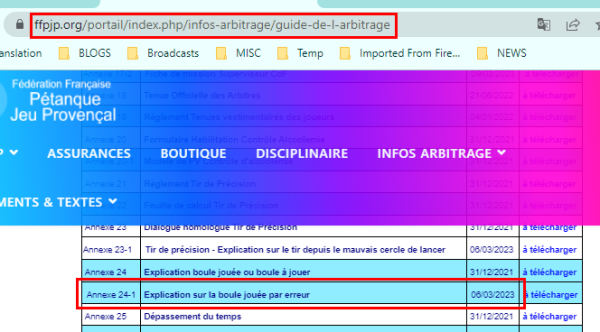
The rightmost column is entitled à teléchargér (to download). To download a document, click on the link in that column. You will be able to download the selected document. It will be in PDF format and (of course) in French. If you don’t read French, I recommend using the DeepL automatic translator.
A new ruling on boules played out-of-turn
updated 2023-08-23
A boule played out-of-turn is a boule that was played when a team mistakenly believed that they did not have the point, and that it was their turn to play.
For a long time, there has been serious debate about what should be done when this happens. Some have argued that a boule played out-of-turn was played “contrary to the the rules” and that Article 24 therefore gives the opposing team the option to declare it to be dead. Others have argued that a boule played out-of-turn was NOT an infringement of the rules but simply a mistake; the boule(s) should be left where they are and play should continue.
As of March 6, 2023, this debate has been settled by a ruling by the FIPJP. It is now official— a boule played out-of-turn is simply a mistake; it should be left in place and play should continue.
I don’t know if this ruling can be found on the FIPJP web site. A French version of it can be found on the FFPJP Guide de l’Arbitrage, and the Oceania Confederation posted a French and English version which you can read HERE.
The … ball played by mistake will be valid until the end of the mène.
This ruling made its way to the “Ask the Umpire” Facebook forum on May 4, 2023. In two separate posts (HERE and HERE) Tony Kidd, Trudy Bishop, Allen Cassady, and Andries Wijand all asked roughly the same question:
If Team B gains the point, but does not measure and (thinking that they have not gained the point) plays a second boule, what is the penalty?
Mike Pegg’s answers (which I have combined and compressed for the sake of readability) were—
The penalty is that Team B has wasted one of its boules. No boules are removed, and play continues. Team B of course should have checked [to verify that they were not holding], but so should team A to be sure they are still holding. If neither team checks to see who is holding, they are both in the wrong. Team B’s second boule remains valid, and they are at a disadvantage having played a boule they didn’t need to play.
It is nice to have this old thorn in the side finally pulled.
Since I first wrote this post I’ve seen several translations of the French text of the memo. They are all adequate but (in my opinion) none of them is very good. So, for what it’s worth, here is my own translation. I have inserted text in [square brackets] for the purposes of clarification of the text.
Explanation of a boule played by mistake
FIPJP decision – 06/03/2023
1 – THE SITUATION EXPLAINED
• Team A plays its first boule.
• Team B points. Team B, thinking that it has not taken the point, plays a second boule which takes the point.
• In doubt about the situation, both teams measure. It turns out that team B had taken the point with its first boule, so team B has 2 points.
2 – THE DECISION
The second boule played by mistake is valid until the end of the mene.
[3 – THE REASON FOR THIS DECISION]
Why is this?
First: the rule does not prohibit a team from playing when it has the point, as long as the measurement has not been made.
Second: such an action typically falls within the scope of an error already sanctioned (by the fact that the team in question is, as a result, deprived of a boule).
Finally: the cancellation of this second boule played by mistake is unenforceable [French: inapplicable].
[Why is the cancellation of this second boule unenforceable?]
* Firstly, if the players don’t immediately realize the error, how is the umpire going to decide when other boules have been played and have displaced one or other of the disputed boules when, by definition, no measurement has been made on them?
* When a dead boule moves other objects, these can be put back in place if marked. A problem immediately arises if these other objects move the jack or one or more boules, especially as (as we all know) markings are rarely accurate to the nearest millimeter.
* It can even happen that as many as nine boules are played after the second boule in question before the players discover that their first boule played had the point!
[4 – CONCLUSION]
The only valid measurement for awarding points is the one that is eventually done at the end of the mene, regardless of the order in which the teams played.
Playing penalties and conduct penalties
I’ve noticed that on his Ask the Umpire Facebook forum Mike Pegg has started using two new terms— or at least terms that I’ve never noticed before— “playing penalty” and “conduct penalty”. I don’t know the origin of these terms, but I think that they are useful. Basically, the new terms highlight an important distinction in faults and penalties, and the terms make it easier to describe and talk about them.
The basic idea is that there are two kinds or categories of “faults” (ways to break the rules) and correspondingly there are two kinds of penalties— playing penalties for playing faults, and conduct penalties for conduct faults.
The first appearance of these terms that I noticed was on February 16, 2023, in a response to a question by Axel Gillman. Axel asked “How long are penalty cards valid in a tournament or cup game?” Mike’s response was
It depends on the reason for the penalty. Generally speaking a “playing penalty” lasts for the game in question. However, “conduct penalties” will remain in force the the full tournament, even if that event is over a number of days or stages. A player may be disqualified for a game or for the tournament, depending on the reason for the disqualification.
About three months later, on May 4, Mike used the terms again, this time in response to a question by Raymond Ager.
The opponents have the point, but they are out of boules. Our shooter is in the circle and about to shoot when an opponent says, “Excuse me, I want to measure to see if we’re holding two,” and proceeds to measure. Normally the opponents shouldn’t move or speak. What is the ruling ?
Mike’s response was
If you had an umpire at your event, he/she should award a warning to the player who interrupted your shooter. It is worth noting that this is considered a “conduct” fault, which is serious, as a repeat of this or any other conduct fault would result in the player being disqualified from the competition— see the closing paragraph of article 17.
Just for the record, the title of Article 17 is Behaviour of players and spectators during a game, and the last paragraph is “The players who do not observe these regulations could be excluded from the competition if, after a warning from an umpire, they persist in their conduct.”
Judging from these two entries, I would summarize the differences this way.
- “Playing” penalties are awarded for violations of the rules of the game. Normally, a first offense would earn a warning (yellow card), while a second offense would get a boule disqualified (orange card). Such a penalty will last only until the end of the game.
- “Conduct” penalties are awarded for violations of the rules of conduct. Normally, a first offense would earn a warning (yellow card), while a second offense could get a player disqualified. The disqualification could be for the remainder of the game or even for the remainder of the competition.
The distinction between playing penalties and conduct penalties is not (or at least not yet) perfect. For one thing, it isn’t written down in any FIPJP document, so at least for now we don’t know if other umpires will recognize and use the distinction. For another, although the distinction seems to be intuitive, it is not sharp— I think there are cases where it isn’t clear whether a particular fault should be considered a playing fault or a conduct fault.
Still, Rome wasn’t built in a day. We shouldn’t fault a move in the right direction for not achieving perfection on Day One. Bottom line— I think that this distinction IS a useful tool for helping players and umpires to think and speak more clearly about the rules.
Leisure boules vs competition boules – when did the distinction begin?
When did people first start distinguishing between leisure boules and competition boules?
It seems to me that it must have begun when the requirements for competition boules were first codified. As the requirement for boules were gradually written down and refined, boule manufacturers must have began to distinguish between their models of boules that met those requirements (“competition” boules) and their models of boules that didn’t meet all of those requirements but were functionally similar and less expensive (“leisure” boules). Assuming that this is what happened, our question turns into a slightly different question— When did the idea of certified “competition” boules first emerge?
Based on our historical archive of the versions of the rules of the game of petanque, the answer appears to be that it happened between 1962 and 1974.
- In 1962 the FIPJP (international) rules first required boules to be certified (agréées) by the the FIPJP.
- In 1964 the FFPJP (French national) rules first required boules to be “agréées par Sa Fédération”.
- In 1970 the French national rules first required boules to be stamped with the boule’s weight.
- In 1974, the French national rules first required boules to be stamped with the manufacturer’s mark.
In 1984, the French national rules were adopted as the FIPJP international rules, and most national federations adopted the FIPJP rules, unchanged, as their national rules. That’s how we got the rules that we have today.
Interestingly, the requirement that competition boules be stamped with the IDs of the boule’s model and set aren’t in the rules of the game. They are in the FIPJP document called Requirements for the Certification of Competition Petanque Boules. Unfortunately, I have no way to trace the history of that document.
THE BOTTOM LINE
If I had to pick a specific year for when the distinction between leisure boules and competition boules first completely emerged, I’d pick 1974. That was the year when the French national rules first required all of the three things that the international rules now require— (1) that boules be certified, (2) that boules be stamped with the boule’s weight, and (3) that boules be stamped with the manufacturer’s mark.
Frequently-asked questions about the rules of petanque
When you’re looking for an answer to a question—
— FIRST find out if the answer is already available on the web.
For frequently-asked questions about the rules of petanque—
— See our page of FAQs.
— See our posts tagged as FAQs.
For “umpire questions”—
— Search our posts for Article 35.
— Search our posts for collective (penalty/ yellow card/ orange card).
Search our pages and posts for any term.
If you still can’t find an answer to your question, you can—
— post your question on Facebook Petanque Q&A forum
— post your question on Facebook “Ask the Umpire” forum
A different way to think about obstacles
Now that the FIPJP rules allow us to throw the jack right up to a side dead-ball line, I’m afraid we’ll never see the end of questions about whether a wooden surround is a pointing obstacle. All we can do is try to develop a clear answer to the question.
The FIPJP rules define two types of obstacles— throwing obstacles and pointing obstacles. The FIPJP rules specify that the throwing circle must be a certain minimum distance from any throwing obstacle, and the thrown (or placed) jack must be a certain minimum distance from any pointing obstacle.
Framing the rules this way focusses our attention on obstacles, and distances from obstacles.
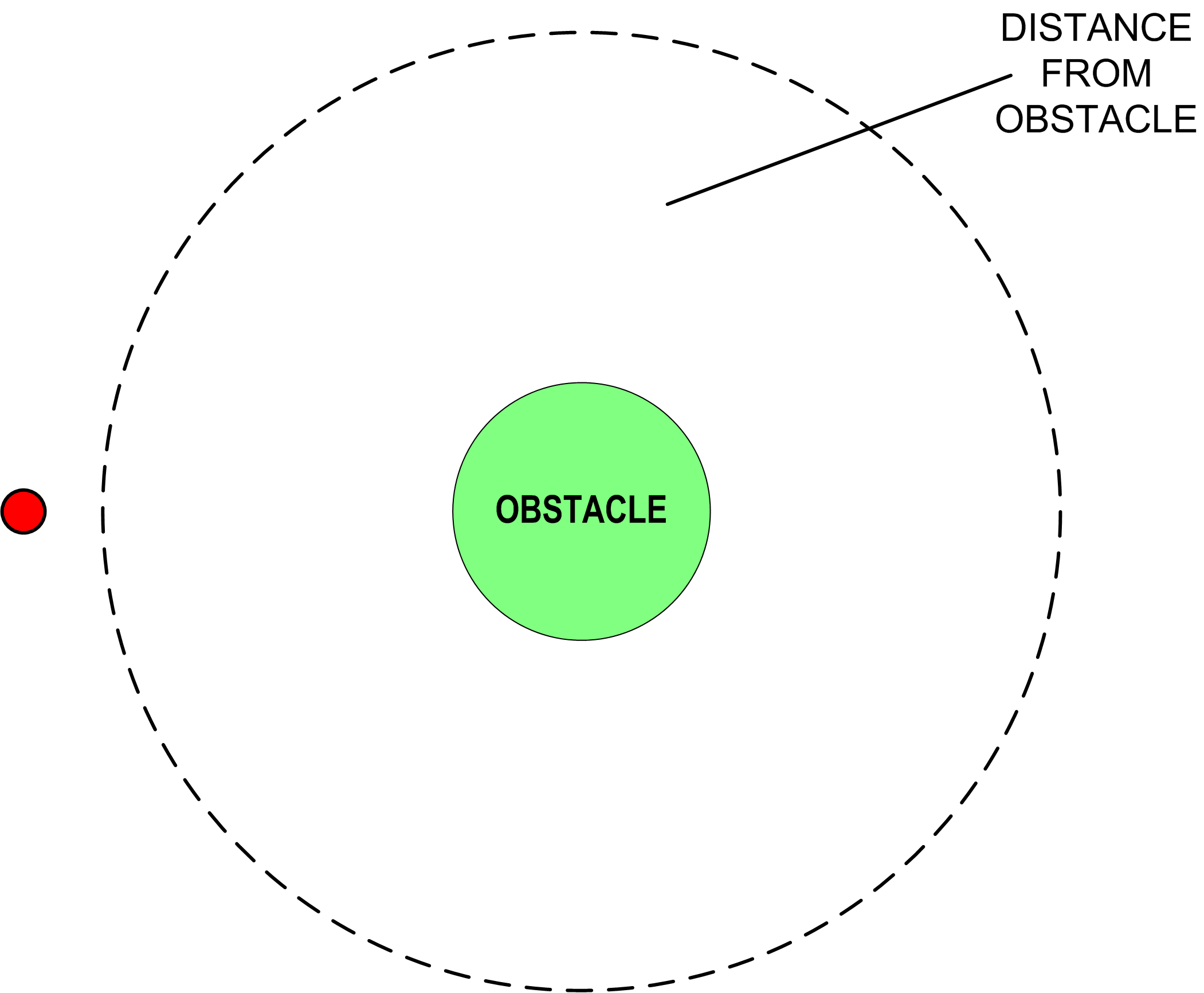
I think that it would be more helpful to instead focus our attention on the objects involved— the jack and the throwing circle— and on the obstacle-free zones that those objects generate.
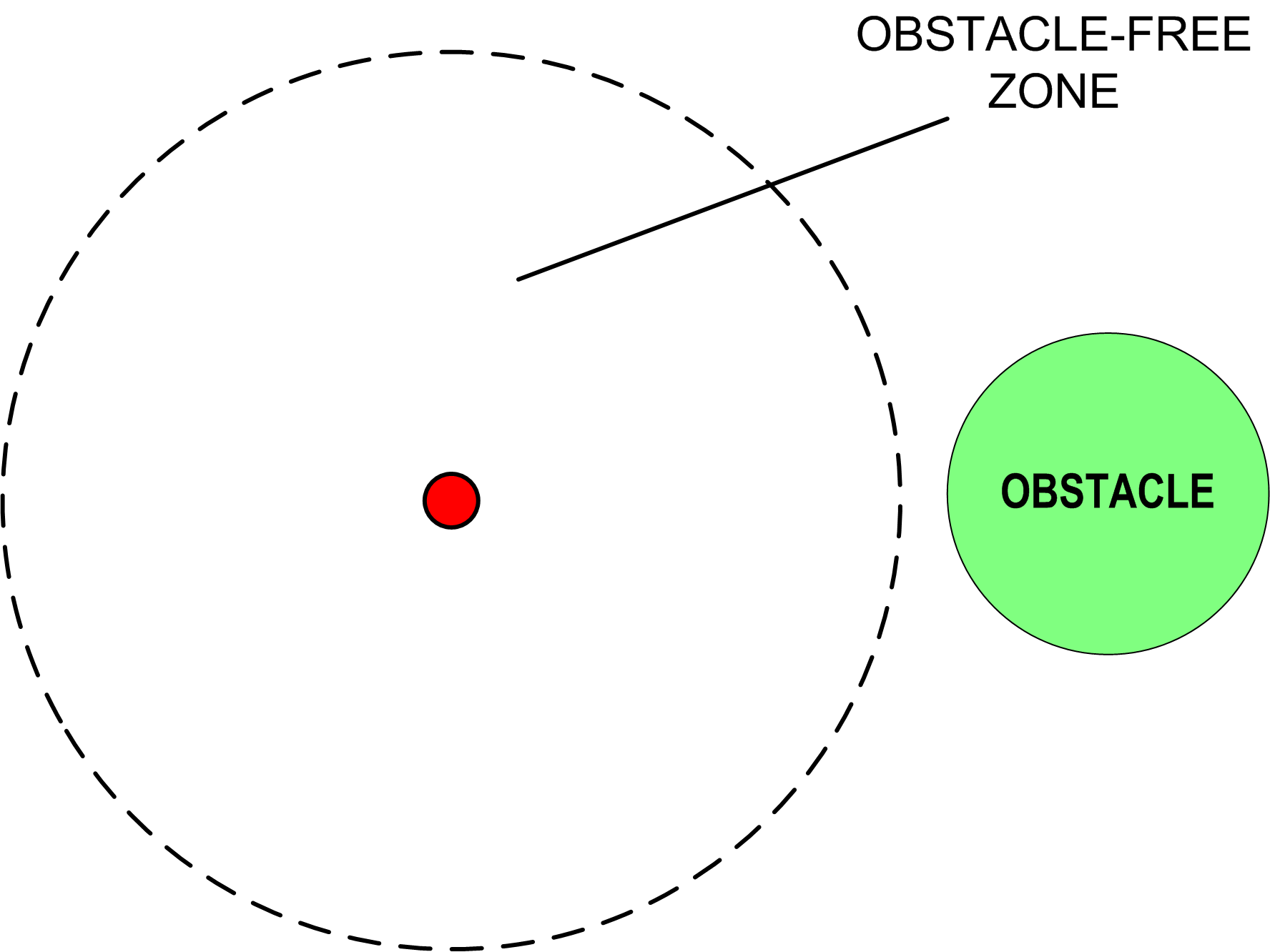
The rule about throwing obstacles is designed to create an obstacle-free area around the circle so that a player, standing in the center of that zone, can throw a boule without fear of hitting something that might injure his/her throwing hand. Basically, a throwing obstacle is an object that could injure a player if it is too close to him/her. That’s why the rule says, basically, that no such objects are permitted in the obstacle-free zone around the circle.
The rule about pointing obstacles is designed to create an obstacle-free area around the jack so that no object will physically prevent a boule from being pointed close to the jack. Basically, a pointing obstacle is an object that prevents a boule from being pointed close to the jack. That’s why the rule says that no such objects are permitted in the obstacle-free zone around the jack.
It’s as simple as that.
Using this point of view, let’s look at a question that came up recently on “Ask the Umpire”.
A boundary string separates lane A and lane B. There is a tree in lane B, close to the boundary string. Is it a pointing obstacle for lane A?
The answer is YES… in the following sense. If the jack is thrown out onto lane A, and if (when the jack comes to rest) the tree is inside the jack’s obstacle-free zone, then the tree is indeed a pointing obstacle. In that case, the thrown jack is not valid.
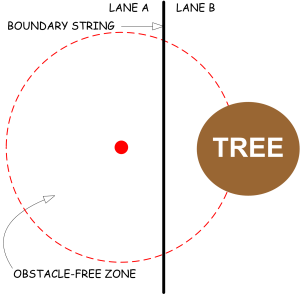
This answer assumes that boules from lane A can roll into lane B without dying, so the obstacle-free zone around the jack extends across the string and into lane B. But what if it is a time-limited game, and the boundary string is also a dead-ball line?
In that case, the jack’s obstacle-free zone extends only 8cm into lane B. If the tree is more than 8cm away from the dead-ball line, it is not within the jack’s obstacle-free zone. That means that the jack can be thrown right next to the dead-ball line and still be valid.
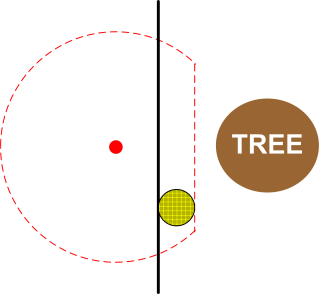
What is so magical about the 8cm distance? The maximum legal diameter of a boule is 8cm. As in the diagram (above), a boule can almost completely cross a dead-ball line and still be alive. But if it rolls any farther, it will die. That means that any object that is more than 8cm outside the dead-ball line can never be a pointing obstacle for a live boule. Any boule that reached it would be DOA: dead on arrival.
Conversely, a tree that is less than 8cm from the dead-ball line could be in the jack’s obstacle-free zone.
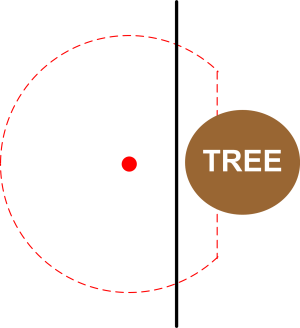
Since no two objects can occupy the same space at the same time, the tree really could be a pointing obstacle. In this diagram (below) we see that the tree really could prevent a live boule from entering part of the obstacle-free zone around the jack. That’s why in this case the thrown jack is invalid.
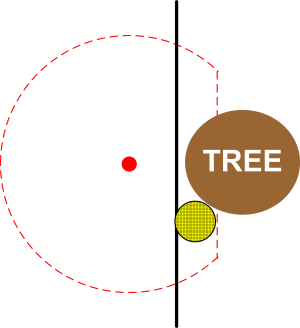
Is a wooden surround a pointing obstacle?
Our terrain is marked by dead-ball strings and enclosed by a wooden surround (boule-stop). Is the wooden surround a pointing obstacle?
The answer is exactly the same for the wooden surround as it was for the tree. A wooden surround that is less than 8cm from the dead-ball string can stop a live boule. So if the wooden surround is less than 8cm from the dead-ball string and less than 50cm from the thrown jack (i.e. inside the jack’s obstacle-free zone) the thrown jack is not valid. This is why a dead-ball string should always be installed more than 8cm from a wooden surround. The recommended minimum distance is 30cm.
Is a wooden surround a pointing obstacle when there is no dead-ball string?
Our terrain is enclosed by a wooden surround, but we have no dead-ball strings. Is the wooden surround considered to be a pointing obstacle?
YES. It is a pointing obstacle, and a thrown or placed jack must be at least 50cm from the wooden surround. Note, however, that because there are no dead-ball strings on your terrain, you are not playing by FIPJP rules— you are playing by your own local rules. You should adopt whatever local rule is agreeable to the two teams.
Challenging the jack
After reading a recent question on “Ask the Umpire” I’ve been thinking about the notion of challenging the jack. I’ve come to the conclusion that the notion of challenging the jack is completely bogus and we should stop using it.

The rule about challenging the jack is brief and cryptic. Article 7 lists the requirements for a thrown jack to be valid, but it doesn’t describe any procedures for determining whether or not the jack meets those requirements. In the next article, Article 8, we find this
If you read the rules carefully, you will notice that the rules never explicitly say that Team A, before it plays its first boule, may make measurements to verify the jack’s validity. Article 8, however, assumes that Team A can do that, and Article 8’s concern is to make it clear that Team B may do the same thing— measure the jack to verify its validity before playing its first boule. If we combine what Article 8 says with what it assumes, the rule that we get is this.
The FIPJP rule as it currently stands is so obfuscated by bad writing and poor vocabulary choices (“challenge the jack”, “objection”) that it confuses both players and umpires. Questions are asked. After Team A has thrown the jack, while one of its players is standing in the circle and ready to throw the first boule, can Team B challenge the jack? If not, why not? If so, what is the correct procedure for doing it? If Team B challenges the jack, can Team A simply ignore the challenge?
All of these questions surfaced again recently, when Allen Cassady posted a question on Mike Pegg’s “Ask the Umpire” Facebook group. Here is a lightly-edited version of that post.
Question #1. May Albert ignore Bob’s comment and proceed to throw his boule? Or, knowing that there is a disagreement as to the validity of the jack, must he stop and let the two teams measure the jack?
Question #2. Should the umpire warn/penalize Bob for violating the first sentence of Article 17, which requires players and spectators to observe total silence before a player plays his boule?
With respect to question #1, international umpire Mike Pegg’s answer was—
It would be in the best interest for Team A to check the validity of the jack before they throw their first boule, especially as Team B are already challenging its position. But your question is— Could Team A go ahead and play their first boule? The answer is YES.
Note that Mike describes Bob’s action as “challenging [the jack’s] position”, but then he says that Albert may ignore Bob’s “challenge”! But… surely if the idea of a right to bring a challenge is a meaningful one, a lawful challenge cannot simply be ignored. That’s why I suspect that Mike regards Bob’s comment simply as a casual remark, and not as a formal challenge. And I suspect that Mike’s answer accurately reflects the meaning and intent of Article 8. And I suspect that Article 8 contains nothing at all like a concept of formally challenging the jack.
If you accept the idea that Article 8 is trying to say that each team, before playing its first boule, may measure the jack, then the concept of “challenging the jack” simply drops out of the rules. And as it disappears it takes along with it all of the questions that it spawned. It becomes clear, for example, that Mike was right. Albert can ignore Bob’s comment, because there is no such thing in the FIPJP rules as formally challenging the jack. Bob’s casual remark was just that: a casual remark.
With respect to question #2 (Should the umpire warn/penalize Bob for violating the Article 17 rule requiring players and spectators to observe total silence before a player plays his boule?), note that the umpire’s job is to apply the rules appropriately, taking into consideration the unique circumstances of each particular situation. In one set of circumstances, an umpire might think it appropriate to give Bob a yellow card. In another set of circumstances, he might not. In this particular case, Mike has no problem with Bob voicing his thoughts; Mike even thinks it was helpful to Team A. A yellow card is not appropriate in this case.
The bottom line is that Article 8 is badly written and misleading. The concept of challenging the jack is not a useful way of understanding Article 8, and we should stop using it. The rule (or if you prefer, the rule interpretation) that we should use is this.
